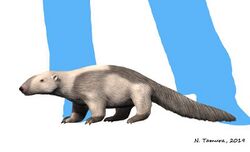Biology:Metacheiromys
| Metacheiromys | |
|---|---|

| |
| Skeleton of Metacheiromys marshi | |

| |
| Reconstruction of Metacheiromys marshi | |
| Scientific classification | |
| Domain: | Eukaryota |
| Kingdom: | Animalia |
| Phylum: | Chordata |
| Class: | Mammalia |
| Order: | †Palaeanodonta |
| Family: | †Metacheiromyidae |
| Subfamily: | †Metacheiromyinae |
| Genus: | †Metacheiromys Wortman, 1903 |
| Type species | |
| †Metacheiromys marshi Wortman, 1903
| |
| Species | |
| Synonyms | |
|
synonyms of species:
| |
Metacheiromys ("next to Cheiromys") is an extinct genus of placental mammals from extinct paraphyletic subfamily Metacheiromyinae within extinct paraphyletic family Metacheiromyidae in extinct order Palaeanodonta, that lived in North America (what is now Wyoming) from the early to middle Eocene.
Etymology
The generic name means "next to Cheiromys" because the scientist who saw the bones mistakenly thought that the animal was a primate with hands like those of the lemurs from genus Daubentonia, whose synonym is Cheiromys.
Characteristics of taxa
Metacheiromys was a small creature, and measured around 45 centimetres (18 in) long. It had long claws and a narrow head similar in shape to that of an armadillo or an anteater (though it was actually related to the modern pangolins). The shape of its claws suggests that it probably dug through the soil in search of food, most likely small invertebrates. Unlike modern anteaters or pangolins, it had powerful canine teeth, but only a very few cheek teeth, instead using horny pads in its mouth to crush its food.[4]
Metacheiromys and its relatives, including the enigmatic Ernanodon, constitute the order Palaeanodonta, thought to be the sister taxon of pangolins.[5]
Phylogenetic tree
The phylogenetic relationships of genus Metacheiromys is shown in the following cladogram:[6][7][5]
| Ferae |
|
Script error: No such module "Clade/labels". | |||||||||||||||||||||||||||||||||||||||||||||||||||||||||||||||||||||||||||||||||||||||||||||||||||||||||||||||||||||
See also
References
- ↑ H. F. Osborn (1904) "An armadillo from the middle eocene (Bridger) of North America." Bulletin of the American Museum of Natural History 20(12):163-165
- ↑ J. L. Wortman (1903) "Studies of Eocene Mammalia in the Marsh Collection, Peabody Museum. Part II. Primates. Suborder Cheiromyoidea." The American Journal of Science, series 4 16:345-368
- ↑ G. G. Simpson (1931) "Metacheiromys and the Edentata." Bulletin of the American Museum of Natural History 59(6)
- ↑ Palmer, D., ed (1999). The Marshall Illustrated Encyclopedia of Dinosaurs and Prehistoric Animals. London: Marshall Editions. p. 206. ISBN 1-84028-152-9.
- ↑ 5.0 5.1 Kondrashov, Peter; Agadjanian, Alexandre K. (2012). "A nearly complete skeleton of Ernanodon (Mammalia, Palaeanodonta) from Mongolia: morphofunctional analysis". Journal of Vertebrate Paleontology 32 (5): 983–1001. doi:10.1080/02724634.2012.694319.
- ↑ Kenneth D. Rose (2008). "Palaeanodonta and Pholidota". 9 - Palaeanodonta and Pholidota. pp. 135–146. doi:10.1017/CBO9780511541438.010. ISBN 9780521781176.
- ↑ Gaudin, Timothy (2009). "The Phylogeny of Living and Extinct Pangolins (Mammalia, Pholidota) and Associated Taxa: A Morphology Based Analysis". Journal of Mammalian Evolution (Heidelberg, Germany: Springer Science+Business Media) 16 (4): 235–305. doi:10.1007/s10914-009-9119-9. http://web2.utc.edu/~gvv824/Gaudin%20et%20al%202009.pdf. Retrieved 2020-08-28.
Wikidata ☰ Q509726 entry
 |

